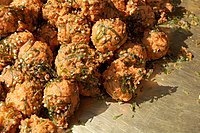Frying
This article needs additional citations for verification. (May 2015) |

Frying is the cooking of food in oil or another fat.[a][1] Similar to sautéing, pan-fried foods are generally turned over once or twice during cooking, using tongs or a spatula, while sautéed foods are cooked by "tossing in the pan".[2] A large variety of foods may be fried.
History[]

This section needs expansion. You can help by . (December 2009) |
Frying is believed to have first appeared in the Ancient Egyptian kitchen, during the Old Kingdom, around 2500 BCE.[3] The first record of frying technique in the western world had been traced from a painting in the 16th century which depicted an old lady frying an egg.[4]
Details[]
Fats can reach much higher temperatures before boiling compared to water. Through frying, one can sear or even carbonize the surface of foods while caramelizing sugars. The food is cooked much more quickly and has a characteristic crispness and texture. Depending on the food, the fat will penetrate it to varying degrees, contributing richness, lubricity, its own flavor, and calories.
Frying techniques vary in the amount of fat required, the cooking time, the type of cooking vessel required, and the manipulation of the food. Sautéing, stir frying, pan frying, shallow frying, and deep frying are all standard frying techniques.
Pan frying, sautéing and stir-frying involve cooking foods in a thin layer of fat on a hot surface, such as a frying pan, griddle, wok, or sauteuse. Stir frying involves frying quickly at very high temperatures, requiring that the food be stirred continuously to prevent it from adhering to the cooking surface and burning.
Shallow frying is a type of pan frying using only enough fat to immerse approximately one-third to one-half of each piece of food; fat used in this technique is typically only used once. Deep-frying, on the other hand, involves totally immersing the food in hot oil, which is normally topped up and used several times before being disposed. Deep-frying is typically a much more involved process, and may require specialized oils for optimal results.
Deep frying is now the basis of a very large and expanding worldwide industry. Fried products have consumer appeal in all age groups and in virtually all cultures, and the process is quick, can easily be made continuous for mass production, and the food emerges sterile and dry, with a relatively long shelf life. The end products can then be easily packaged for storage and distribution. Some include potato chips, french fries, nuts, doughnuts, and instant noodles.

Tofu being fried

Fried polenta, French fries, and fried chicken at a Brazilian eatery

Pakora is a fried snack, popular throughout the Indian subcontinent, served in Jaipur, India.
See also[]
Notes[]
- ^ Chemically, oils and fats are the same, differing only in melting point, and the distinction is only made when needed. Foods can be fried in a variety of fats, including lard, vegetable oil, rapeseed oil, and olive oil. In commerce, many fats are called oils by custom, e.g. palm oil and coconut oil, which are solid at room temperature.
References[]
- ^ editor, Prosper Montagné ; American; Escoffier, Charlotte Turgeon ; pref. by Robert J. Courtine ; original preface by Auguste; Hunter, Philéas Gilbert ; text translated from the French by Marion (1977). The New Larousse Gastronomique : The Encyclopedia of Food, Wine & Cookery. New York: Crown Publishers. pp. 299, 307. ISBN 0-517-53137-2.CS1 maint: extra text: authors list (link)
- ^ Peterson, James (April 2003). Essentials of Cooking. Artisan Books. ISBN 978-1-57965-236-4.
- ^ Tannahill, Reay. (1995). Food in History. Three Rivers Press. p. 75
- ^ Morton, I. D. (1998-08-30). "Geography and history of the frying process". Grasas y Aceites. 49 (3–4): 247–249. doi:10.3989/gya.1998.v49.i3-4.745. ISSN 1988-4214.
External links[]
| Wikibooks Cookbook has a recipe/module on |
- Cooking techniques
- Food preparation techniques
- Culinary terminology
- Fried foods




